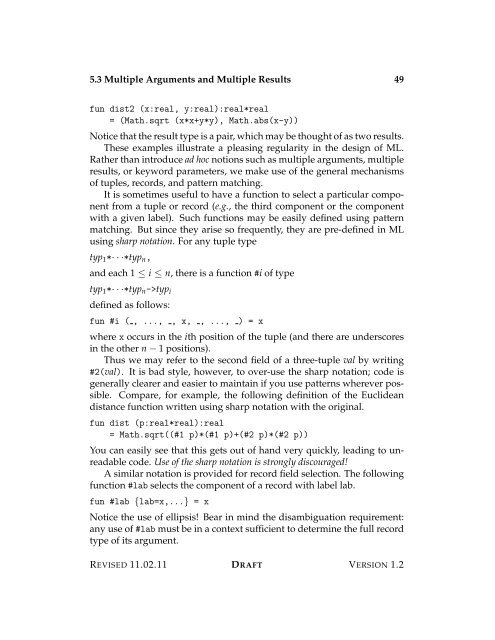sml
You also want an ePaper? Increase the reach of your titles
YUMPU automatically turns print PDFs into web optimized ePapers that Google loves.
5.3 Multiple Arguments and Multiple Results 49<br />
fun dist2 (x:real, y:real):real*real<br />
= (Math.sqrt (x*x+y*y), Math.abs(x-y))<br />
Notice that the result type is a pair, which may be thought of as two results.<br />
These examples illustrate a pleasing regularity in the design of ML.<br />
Rather than introduce ad hoc notions such as multiple arguments, multiple<br />
results, or keyword parameters, we make use of the general mechanisms<br />
of tuples, records, and pattern matching.<br />
It is sometimes useful to have a function to select a particular component<br />
from a tuple or record (e.g., the third component or the component<br />
with a given label). Such functions may be easily defined using pattern<br />
matching. But since they arise so frequently, they are pre-defined in ML<br />
using sharp notation. For any tuple type<br />
typ 1 *· · ·*typ n ,<br />
and each 1 ≤ i ≤ n, there is a function #i of type<br />
typ 1 *· · ·*typ n ->typ i<br />
defined as follows:<br />
fun #i ( , ..., , x, , ..., ) = x<br />
where x occurs in the ith position of the tuple (and there are underscores<br />
in the other n − 1 positions).<br />
Thus we may refer to the second field of a three-tuple val by writing<br />
#2(val). It is bad style, however, to over-use the sharp notation; code is<br />
generally clearer and easier to maintain if you use patterns wherever possible.<br />
Compare, for example, the following definition of the Euclidean<br />
distance function written using sharp notation with the original.<br />
fun dist (p:real*real):real<br />
= Math.sqrt((#1 p)*(#1 p)+(#2 p)*(#2 p))<br />
You can easily see that this gets out of hand very quickly, leading to unreadable<br />
code. Use of the sharp notation is strongly discouraged!<br />
A similar notation is provided for record field selection. The following<br />
function #lab selects the component of a record with label lab.<br />
fun #lab {lab=x,...} = x<br />
Notice the use of ellipsis! Bear in mind the disambiguation requirement:<br />
any use of #lab must be in a context sufficient to determine the full record<br />
type of its argument.<br />
REVISED 11.02.11 DRAFT VERSION 1.2







